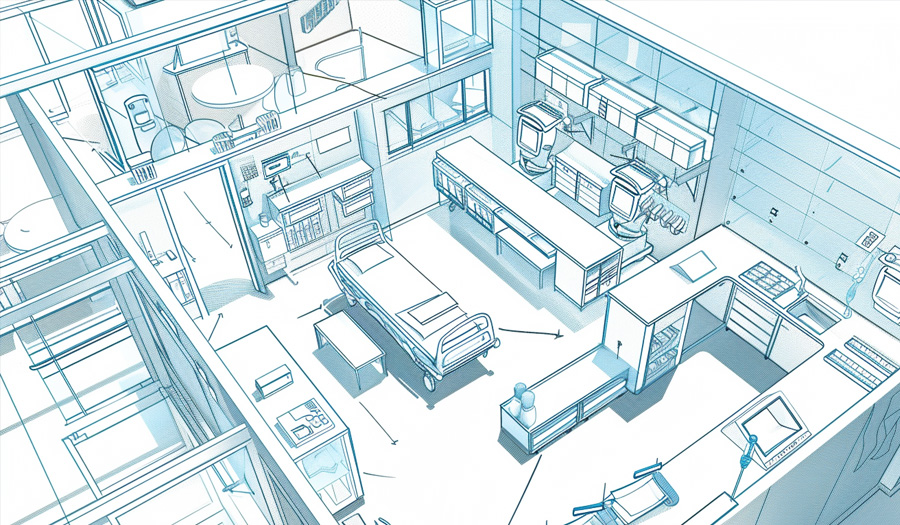
Modernizing Healthcare: A VAR's Guide to Unique Solutions & Opportunities
Healthcare is a lucrative industry that most technology resellers would love to enter. This market promises vast potential, but success hinges on more than competitive pricing and generic technology. Unlike other sectors, healthcare is notorious for its complex procurement processes, deeply entrenched vendor relationships, and purchasing gatekeepers who prioritize the bottom line.
The healthcare landscape can be a frustrating puzzle for VARs accustomed to winning bids with the lowest-cost barcode scanners or mobile computers. Here, commoditized tech often takes a backseat, and true value lies in offering solutions that address specific pain points.
This article explores how VARs can navigate these complexities and carve a niche in the healthcare market. We'll examine the value of partnering with software companies specializing in healthcare solutions. By focusing on integrated software and services, VARs can move beyond selling basic hardware and become trusted advisors on topics that matter to healthcare organizations, like improving patient care, operational efficiencies, and business outcomes.
Let’s begin by exploring software solutions at the center of some of BlueStar’s most successful marketing campaigns. These campaigns focused on innovative software solutions in areas where hospitals struggle most, and the technology seamlessly integrated with the hardware our VARs were already selling. These solutions are only a few of the many ways VARs can partner with ISVs to better compete in the healthcare space.
RFID & Infant Identification

Challenge: Fragile Newborns in NICUs often do not get barcode wristbands to minimize disturbance, leading to a high risk of misidentification (ECRI Institute reports a 91% error rate due to missing wristbands).
Solution: RFID-embedded bands
Implementation: Small, comfortable tags are attached to the infant's ankle, easy to read without touching, moving, or waking the child
Hospital/Patient Benefits:
- Real-time tracking throughout designated areas.
- Minimized risk of abduction, unauthorized removal, or misidentification for treatments or medicine.
- Improved efficiency with faster location of specific babies.
- Integration with EMR systems for instant access to vital information.
This approach safeguards infant safety and streamlines workflows for NICU staff.
You can learn more about how RMS Omega and Zebra Technologies are implementing non-disruptive infant patient identification by viewing our eBook here.
Sepsis: Beyond Detection
Challenge: Sepsis is a leading cause of death in hospitals, with inadequate care beyond detection being a major issue.
- Only 58% of patients receive appropriate post-detection care (CMS).
- Many hospitals lack FDA-approved automated sepsis bundle delivery solutions, which are crucial for improved survival.

Solution: Implementing FDA Class II-approved software platforms can significantly improve compliance with sepsis bundles
Benefits:
- Faster diagnosis through point-of-care testing and automated blood cultures.
- Streamlined order entry for antibiotics and fluids via EHR integration.
- Electronic decision support for proper medication dosages.
- Real-time data for continuous patient assessment and improved communication.
- Potential reduction in hospital stay length or readmissions.
FDA-approved technology empowers VARs to offer solutions that enhance sepsis care, patient outcomes, and hospital efficiency.
Click here to learn more about “Sepsis Compliance Beyond Detection” and how Ambient and Zebra Technologies are implementing solutions to help.
The Future of Wound Care
Challenge: The growing burden of chronic wounds on healthcare systems is undeniable. An aging population, coupled with a steady increase in chronic conditions like diabetes and heart disease, creates a perfect storm. Social, economic, and technological barriers further complicate the ability of many to receive proper care. Wound care has always required a great amount of time and attention from an already overburdened healthcare system.
Solution: Mobile wound care apps for chronic wound management.
Benefits:
- Standardized Data Capture: Digital tools ensure accurate and consistent wound measurements, minimizing errors associated with traditional methods like rulers.
- Improved Documentation: Images and annotations captured directly in the app eliminate paper records and manual data entry, streamlining workflows and reducing errors.
- Enhanced Communication: Secure mobile apps facilitate seamless information sharing between nurses, doctors, and patients, promoting collaboration and continuity of care.
- Elevated Patient Care: Improved data accuracy and efficient workflows lead to higher-quality care management. By eliminating paperwork, healthcare providers can dedicate more time to patient interaction and bedside care. Additionally, mobile wound care allows for remote monitoring, potentially reducing unnecessary hospital visits.
- Potential Cost Reductions
Mobile wound care apps are a game-changer in chronic wound management. They promote efficiency, accuracy, and improved patient outcomes, offering a significant step forward in wound care delivery.
If you would like to learn more about our campaign with Futura and Zebra Technologies, you can view our eBook here.
So, what does this all mean to VARs?
These campaigns focused on specific hospital needs before hardware was brought into the equation. By researching or talking with your customer about their most pressing needs, you lay the groundwork for the software that can help them improve and, ultimately, the hardware you will sell, opening the door to future opportunities.
But it all starts with knowing your customers' needs. What pain points are impacting their outcomes and patient satisfaction? Where are staff shortages impacting the point of care? What solutions would help them? How are they evolving, and what can you do to support them in their journey? Start with their needs and work backward until the hardware you’re selling and the solution they need become a perfect pair.
VARs in Healthcare: 5 Tips to Be a Reliable Partner
While healthcare solutions vary from facility to facility, we’ve compiled a broad list of things VARs can do to accommodate healthcare professionals' tech needs.
- Offer compatible hardware: Supply hospitals with reliable, healthcare-specific, and secure equipment (tablets, mobile devices, RFID tags, readers, etc.)
- Ask about existing systems (integration is key): Offering products that integrate with existing systems is critical. Always ask questions and really get to know everything about any new prospect BEFORE pitching your solution. It will then be easier to equip them with hardware, such as monitoring systems and RFID technology, that meets their facilities' needs.
- Offering ongoing support: Any technical support, training, and maintenance you can provide will go a long way and aid in optimal system functionality, user adoption, and efficient utilization. This can also help you position purpose-built against consumer devices. The initial cost of consumer devices may appeal to budget-conscious procurement specialists, but the total cost of ownership increases dramatically without support and the burden of shorter lifecycles.
- Guarantee data security: Hospitals prioritize data privacy and security, so familiarizing yourself with HIPAA laws and helping healthcare administrators with compliance issues, secure data storage, and access control protocols will work in your favor.
- Focus on cost-effectiveness: How will your solutions save the hospital money or improve staff efficiency? Maybe it’s a reduction in 30-day readmissions (hospitals spend $52.4 billion annually per AHRQ), or the solution might reduce the need for additional staff. Whatever the case, cost will always factor into decisions.
If you are a VAR working with healthcare providers to improve their patient care technology systems, remember to focus on solutions before products and their needs before specs, and keep building up your business as a full solutions provider.
If you need help, BlueStar is here for you. To discuss the latest healthcare technology and potential ISV partnerships, contact our Healthcare BDM, JoAnna Witting -- jwitting@bluestarinc.com.



.png)



